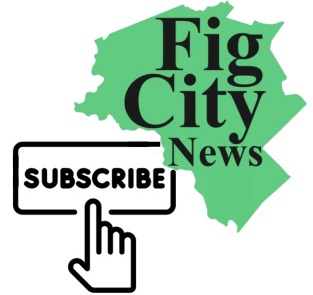Nearly four months after the City’s initial Washington Street Pilot proposal, the Newton Planning Department, the Department of Public Works, the Department of Parks, Recreation and Culture, and the project consultants presented the updated project design, now 75% completed. The design focuses on Washington Street from Lowell Avenue to Chestnut Street. The public meeting webinar on April 11 attracted seventy-five people — a mix of City Councilors and residents, many of whom had attended the January 17 presentation, when the proposed redesign was 25% completed.
The proposed projct will reduce the current four-lane roadway into three lanes: one eastbound, one westbound, and turn lanes on the north side of Washington Street. The south side of Washington Street, along the Massachusetts Turnpike and MBTA Commuter track, will feature East and West bike lanes sharing a pedestrian path, and elevated bus stops. In addition, plans provide for parking on both sides of Washington Street, some plantings along the south side path to block the view of the train tracks and the Mass Pike, and a number of well-defined crossing islands for pedestrians and bikes. A continuous bike path from Chestnut Street will also provide a safe route for students biking to Newton North High School.
The 25% design presented on January 17 showed a long line of concrete tree planters separating the south-side pedestrian and bicycle path from the car travel lane. In the latest design, they have been reduced to only five planters because of the expense of their upkeep. Bryan Jereb, representing the landscape consultants Halvorson, Tighe and Bond, explained that the new design includes flowering and durable plants and bushes as well as shorter trees to screen out the Mass Pike and the MBTA tracks. According to the City’s Director of Parks + Open Space, Luis Perez Demorizi, the watering and maintenance of the plants would be the responsibility of the contractor until the plantings are established.
Barney Heath, Director of Planning and Development, and Ned Codd, Director of Transportation, for the Department of Public Works (DPW), reiterated that the pilot program is meant to:
- Reduce fatalities and serious injuries,
- Reduce speeds and conflicts,
- Provide a safe bike lane in each direction,
- Provide a pedestrian path to address the pedestrian gap on the south side of Washington Street,
- Provide ample parking, and
- Provide more green space.
At the same time, they emphasized that all the changes would be done with temporary measures — painted pavement and road and pedestrian signs, portable bus platforms, and temporary curbing. No permanent changes — such as sidewalks or light signals — would be made, thereby allowing for adjustments. In fact, the less than one-mile stretch of Washington Street has no light signals from Lowell Avenue to Chestnut Street. “The beauty of the pilot is that its features can be tweaked over time,” according to Mr. Heath.
The three Ward 2 City Councilors ––David Micley, Susan Albright, and Tarik Lucas — began the public response by emphasizing the need for a left-hand signal on the traffic light at the intersection of Lowell Avenue and Washington Street. All three noted the back-up and frustration of drivers attempting to turn left onto Lowell Avenue from Washington Street. Councilor Albright said she had been dealing with that frustration for more than thirty years. Councilor Lucas termed it “a quality of life” issue. He also asked about measures to mitigate pollution, noise, and heat islands. Mr. Codd responded that there were no plans to add a left-lane signal to the light at the Lowell Avenue/Washington Street intersection because of the expense. Councilor Micley reiterated his request that the City find a way to provide the left-turn signal. Adrian Ayala from DPW explained that the crash rate at the intersection was lower than the average crash rate at similar signal-light intersections, according to MassDOT guidelines.
Councilor Pam Wright, who with Councilor Albright serves on the Pilot Program Advisory Committee, asked if there will be a left-hand turn lane at Dunstan Street at the completion of construction of the large Chapter 40B apartment complex to be built there. She and Councilors as well as other members of the public said they wanted to know what metrics would be in place to determine if the pilot program was successful. Mr. Heath responded that the team would be tracking a range of numbers from the project, which would be a determinant of its success. He also suggested that the transformation of the street might bring in state money for the contemplated pilot area and for more roadway projects along Washington Street to Newton Corner.
Asking, “What does success look like?,” Councilor John Oliver insisted that there had to be specific parameters for determining success, such as the reduction of speed, the impact of the changes on other streets, the congestion at intersections, the increase in bicycles and pedestrians. Councilor Julia Malakie asked about the current counts for pedestrians, cars, and bicycles. Project consultant Jessica Lizza said they had compiled those figures. Mr. Heath responded that “everyone may have a different interpretation of what constitutes success.” Councilor Albright said that for her, success means transforming the current urban roadway into a suburban street.
Among the residents commenting, Nancy Solari said she wanted pedestrian-activated crossing signals and air-pollution mitigation. Kathleen Kouril Grieser lamented the lack of trees on the north side of Washington Street, which is the more likely pedestrian choice but currently not conducive to use because it lacks trees. Many also complained of the noise from the Mass Pike. Ed Olhava, President of Bike Newton, was enthusiastic about the inclusion of bike lanes, but he, too, mentioned the need for a left-turn light signal at the Washington Street/Lowell Avenue intersection. Former City Councilor Amy Sangiolo thought the shared path on the south side might not be wide enough for pedestrians, bike riders, and the bus stop platforms, but she was enthusiastic about the suggestion from a resident that there be diagonal striping for crosswalks.
MaryLee Belleville questioned the timing of the pilot project, citing the large Dunstan East Chapter 40B project (now known as Newton Crossing), another large complex slated for the West Newton Armory, and a third residential project at Washington and Walker Streets. She suggested it may be better to wait to assess the impact of those developments, but City staff noted that the $2 million to fund the project comes from the American Rescue Plan Act (ARPA), which must be committed by December 31.
The team promised to consider the suggestions and comments raised before presenting its final design to the Public Facilities Committee, scheduled for May 15. After the May 15 hearing, the complete design package will then be presented to the full City Council. The $500,000 needed for the project design is funded by proceeds from Newton’s cannabis agreement. The pilot project – running for an unspecified time – will be funded by $2 million of Newton’s ARPA allocation.




